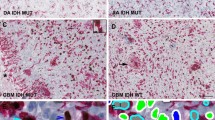Abstract
Glioma, the most common primary brain tumor, is characterized by proliferative-invasive growth. However, the detailed biological characteristics of invading glioma cells remain to be elucidated. A monoclonal antibody (clone HMab-1) that specifically and sensitively recognizes the isocitrate dehydrogenase-1 (IDH1) protein carrying the R132H mutation can identify invading glioma cells by immunostaining. To investigate the degree of invasion in gliomas of distinct grades and the proliferative capacity of the invading cells, immunofluorescent staining was conducted using antibodies against IDH1-R132H and Ki-67 on 11 surgical and autopsy specimens of the tumor core and the invading area. Higher numbers of IDH1-R132H-positive cells in the invading area correlated with a higher tumor grade. Double staining for IDH1-R132H and Ki-67 demonstrated that most invading cells that expressed IDH1-R132H were not stained by the Ki-67 antibody, and the ratio of Ki-67-positive cells among IDH1-R132H-positive cells was significantly lower in the invasion area than in the tumor core in all grades of glioma. These data suggest that higher grade gliomas have a greater invasive potential and that invading cells possess low proliferative capacity.


Similar content being viewed by others
Abbreviations
- IDH1:
-
Isocitrate dehydrogenase1
- GBM:
-
Glioblastoma
References
Nakada M, Nakada S, Demuth T et al (2007) Molecular targets of glioma invasion. Cell Mol Life Sci 64:458–478
Raghunathan A, Olar A, Vogel H et al (2012) Isocitrate dehydrogenase 1 R132H mutation is not detected in angio-centric glioma. Ann Diagn Pathol 16:255–259
Sayson M, Marie Y, Paris S et al (2009) Isocitrate dehydrogenase 1 codon 132 mutation is an important prognostic biomarker in gliomas. J Clin Oncol 27:4150–4154
Capper D, Zentgraf H, Balss J et al (2009) Monoclonal antibody specific for IDH1 R132 mutation. Acta Neuropahtol 118:599–601
Kaneko MK, Ogasawara S, Kato Y (2013) Establishment of a novel multi-specific monoclonal antibody MsMab-1 recognizing both IDH1 and IDH2 mutations. Tohoku J Exp Med 230:103–109
Camelo-Piragua S, Jansen M, Ganguly A et al (2010) Mutant IDH-1 specific immunohistochemistry distinguishes diffuse astrocytoma from astrocytosis. Acta Neuropathol 119:509–511
Giese A, Loo MA, Tran N et al (1996) Dichotomy of astrocytoma migration and proliferation. Int J Cancer 67:275–282
Mariani L, Beaudry C, McDonough WS et al (2001) Glioma cell motility is associated with reduced transcription of pro-apoptotic and proliferation genes: a cDNA microarray analysis. J Neurooncol 53:161–176
Louis DN, Ohgaki H, Wiestler OD et al (2007) The 2007 WHO classification of tumors of the nervous system. Acta Neuropathol 114:97–109
Nakada M, Kita D, Teng L et al (2013) Receptor tyrosine kinases: principles and functions in glioma invasion. Adv Exp Med Biol 986:143–170
Yoshida Y, Nakada M, Harada T et al (2010) The expression level of sphingosine-1 phosphate receptor type 1 is related to MIB-1 labeling index and predicts survival of glioblastoma patients. J Neurooncol 98:41–47
Oka H, Utsuki S, Tanizaki Y et al (2013) Clinicopathological features of human brainstem gliomas. Brain Tumor Pathol 30:1–7
Wang M, Wang T, Liu S et al (2003) The expression of matrix metalloproteinase-2 and-9 in human gliomas of different pathological grades. Brain Tumor Pathol 20:65–72
Nakada M, Nakamura H, Ikeda E et al (1999) Expression and tissue localization of membrane type-1, 2, and 3 matrix metalloproteinase in human astrocytic tumors. Am J Pathol 154:417–428
Nakada M, Kita D, Futami K et al (2001) Roles of membrane type 1 matrix metalloproteinases and tissue inhibitor of matrix metalloproteinases 2 in invasion and dissemination of human malignant glioma. J Neurosurg 94:464–473
Deng Z, Yan Y, Zhong D et al (2010) Quantitative analysis of glioma cell invasion by diffusion tensor imaging. J Clin Neurosci 17:1530–1536
Takano S, Tian W, Matsuda M et al (2011) Detection of IDH1 mutation in human gliomas: comparison of immunohistochemistry and sequencing. Brain Tumor Pathol 28:115–123
Kloosterhof NK, Bralten LB, Dubbink HJ et al (2011) Isocitrate dehydrogenase-1 mutations: a fundamentally new understanding of diffuse glioma? Lancet Oncol 12:83–91
Watanabe T, Nobusawa S, Kleihues P et al (2009) IDH1 mutations are early events in the development of astrocytomas and oligodendrogliomas. Am J Pathol 174:1149–1153
Giese A, Bjerkvig R, Berens ME et al (2003) Cost of migration: invasion of malignant gliomas and implications for treatment. J Clin Oncol 21:1624–1636
Dalrymple SJ, Parisi JE, Roche PC et al (1994) Changes in proliferating cell nuclear antigen expression in glioblastoma multi-forme cells along a stereotactic biopsy trajectory. Neurosurgery 35:1036–1044
Schiffer D, Cavalla P, Dutto A et al (1997) Cell proliferation and invasion in malignant gliomas. Anticancer Res 17:61–69
Acknowledgments
The authors are grateful to Akiko Imamura for help with immunohistochemistry.
Author information
Authors and Affiliations
Corresponding author
Rights and permissions
About this article
Cite this article
Sabit, H., Nakada, M., Furuta, T. et al. Characterizing invading glioma cells based on IDH1-R132H and Ki-67 immunofluorescence. Brain Tumor Pathol 31, 242–246 (2014). https://doi.org/10.1007/s10014-013-0172-y
Received:
Accepted:
Published:
Issue Date:
DOI: https://doi.org/10.1007/s10014-013-0172-y




